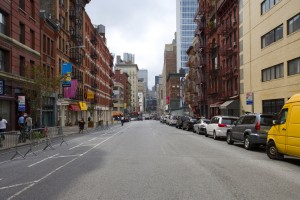Soho, a neighborhood in New York City, is considered as the crossroads of Manhattan. It is quite notable for several artist lofts and art galleries, and just recently, more stores and shops were added. These include the trendy boutiques and outlets of international chain stores. The history of the area is indeed rich, which covers socio-economic, cultural, political, as well as architectural developments.
Almost all areas in Soho is included in the Soho-Cast Iron Historic District. This was designated by the New York City Landmarks Preservation Commission in the year 1973, which was extended in 2010. The district was declared as a National Historic Landmark in the year 1978. It covers 26 blocks, which has approximately 500 different buildings. Most of these buildings incorporate cast iron as one of the architectural elements, thus, the name of the district. Moreover, the side streets are being paved with Belgian blocks.
You may be wondering, why SoHo? Well, the name “SoHo” refers to the place being the “South of Houston Street”. It is also a reference to the London district of Soho. The name was coined by Chester Rapkin, an urban planner, author of “South Houston Industrial Area”, also called as the “Rapkin Report”. The district’s name became the model for developing new names for the neighborhoods like the Tribeca for “Triangle Below Canal Street”, and the Noho for “North of Houston Street”.
The Soho Neighborhood
Soho is a specifically-zoned neighborhood, which is bounded roughly by the Houston street on the northern side, Lafayette Street and Centre Street on the east, Canal Street at the south, and last but not the least, the West Broadway on the west side. Nearby neighborhoods are the following: Greenwich Village, Noho, Nolita, Little Italy, Chinatown, South Village, Hudson Square, and the Tribeca.
The Cast-Iron Architecture
Soho is indeed proud of its greatest collection of cast-iron architecture. This is the defining characteristic of Soho, its unique and fine buildings. There are about 250 buildings that stand in New York which are made in cast-iron, and most of which are in Soho. Back then, cast iron was used as a decorative front for buildings. Along with the modern facades, these older buildings have attracted numerous commercial clients. Majority of the facades were constructed from the year 1840 to 1880. Later on, to revitalize the older structures in the area, these were designed to feature the cast iron.
Cast iron is generally cheaper for facades, compared to stones and bricks. The buildings were made quickly back then. Some even stood in just four months of construction. Despite the short period, the quality of the cast iron designs was still exemplary. This inexpensive cast iron was believed to provide intricate design patterns. The most frequently used architectural designs are Classical French and Italian.
Why live in Soho?
As the crossroads of Manhattan, Soho can provide a comfortable home for those who love the city lights. There are indeed many reasons to choose the Soho neighborhood. Here is a summary of the things people love most about Soho.
- Unique, cast-iron architecture of buildings
- Center for arts and related stuff
- Surrounded by both local and international shops
- Rich with the history of New York



